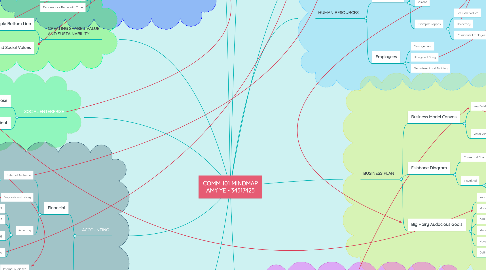
1. INNOVATION AND ENTREPRENEURSHIP
1.1. Transient Advantage
1.1.1. Five Stages
1.1.1.1. Launch
1.1.1.2. Ramp Up
1.1.1.3. Exploitation
1.1.1.4. Reconfigure
1.1.1.5. Disengage
1.1.2. Short-Lived
1.1.3. Constant Change
1.1.3.1. No Perfect Strategy
1.2. Entrepreneurs
1.2.1. Independent
1.2.2. Personally Raises Funds
1.2.3. Full Risk Taken
1.2.4. More Freedom in Innovation
1.3. Intrapreneurs
1.3.1. Dependent
1.3.2. Company Raises Funds
1.3.3. Does Not Bear Full Risk
1.3.4. Operate Within Company Restraints
1.4. Disruptive Innovation
1.4.1. Creates New Market
1.4.2. Disrupts Incumbent Firms
1.4.3. Targets Overlooked Segments
1.4.4. Performance Better with Time
2. CREATING SHARED VALUE AND SUSTAINABILITY
2.1. Triple Bottom Line
2.1.1. Social
2.1.2. Environmental
2.1.3. Economic
2.2. Economic and Social Values
2.2.1. Profit Maximization
3. SOCIAL ENTERPRISE
3.1. Social Purpose
3.1.1. Driven by its Mission
3.1.2. Benefits Communities
3.2. Self-Sufficient
3.2.1. Not Charities
3.2.2. Makes Own Profit
4. ACCOUNTING
4.1. Financial
4.1.1. External Audience
4.1.1.1. Auditors
4.1.1.2. Stakeholders
4.1.1.3. Customers
4.1.2. Emphasis on History
4.1.3. Accuracy
4.1.3.1. Complies with the IFRS
4.1.3.2. Uses the GAAP
4.1.3.3. Fraudalent Accounting
4.1.3.3.1. Illegal
4.1.3.3.2. Unethical
4.1.3.4. Ethical Issues
4.2. Managerial
4.2.1. Internal Audience
4.2.1.1. Managers
4.2.1.2. CEO
4.2.2. Emphasis on the Future
4.2.3. Supplies Necessary Information
5. ALUMNI
5.1. New Perspectives on Sauder
5.1.1. Springboard for Growth
5.1.2. Opportunity for Improvement
5.1.3. Okay to not know your Career Path
5.1.4. People often Change Careers after Graduation
6. BUSINESS PLAN
6.1. Business Model Canvas
6.1.1. Key Building Blocks
6.1.1.1. Nine in Total
6.1.1.2. Interconnected
6.1.1.3. Key Business Elements
6.1.2. Visual Aid
6.1.2.1. One Page Template
6.1.2.2. Easy to Read
6.2. Fishbone Diagram
6.2.1. Cause and Effect Analysis
6.2.1.1. Problem Solving
6.2.1.2. New Innovations
6.2.2. Visual Aid
6.2.2.1. Easy to Read
6.2.2.2. Clear Cause and Effects
6.3. Big Hairy Audacious Goals
6.3.1. Important
6.3.2. Motivation
6.3.3. Difficult to Achieve
6.3.3.1. 'Shoot for the Moon'
6.3.4. Measurable
6.3.5. Have a Finishing Line
6.3.6. Defines Core Values
7. BUSINESS ETHICS
7.1. Stakeholder Theory
7.1.1. Core Values are #1
7.1.1.1. Ethical decisions
7.1.1.2. Integrity
7.1.2. Corporate Social Responsibility
7.2. Shareholder Theory
7.2.1. Profit Maximization is #1
8. TEAMWORK
8.1. Requirements
8.1.1. Responsibility
8.1.2. Accountability
8.1.3. Communication
8.1.4. Common Goals
8.2. Team Charter
8.2.1. Individual Roles
8.2.2. Expectations
8.2.3. Failure to Meet Expecations
8.2.4. Scheduling
9. HUMAN RESOURCES
9.1. Work Culture
9.1.1. Beliefs
9.1.2. Core Values
9.1.3. Attitudes
9.1.3.1. Work for the money
9.1.3.2. Work for enjoyment
9.1.4. Visions
9.1.5. Example: Zappos
9.1.5.1. Ten Core Values
9.1.5.2. Holacracy
9.1.5.3. Passionate Employees
9.2. Employees
9.2.1. Management
9.2.2. Hiring and Firing
9.2.3. Recruitment and Training
10. MARKETING
10.1. Market Segments
10.1.1. Demographics
10.1.2. Price
10.1.3. Customer Loyalty
10.1.4. Psychological Factors
10.2. Points of Difference
10.2.1. Unique to Company
10.2.2. Differentiation is Key!
10.3. Points of Parity
10.3.1. Unique to Several Competitors
10.3.2. Unique to Industry
10.4. Emotional Impact
10.4.1. Example: Dove Soap
10.4.1.1. Specific Value Proposition
10.4.1.2. Convinced Consumers They Care
10.4.1.3. Campaigned for Recognition of Natural Beauty
10.4.2. "People Don't Buy What You Do, They Buy Why You Do It" (Sinek, 2010)

